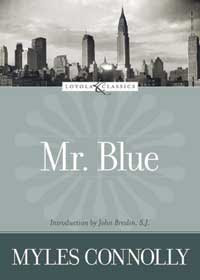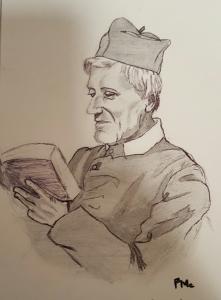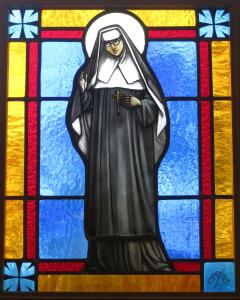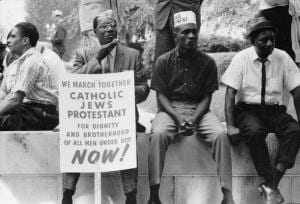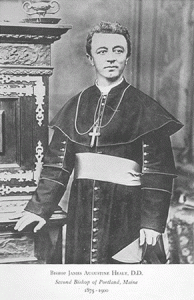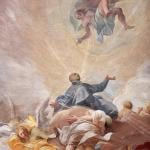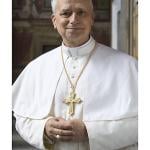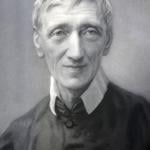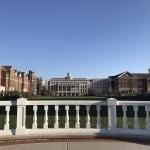Loyola Press has been reprinting somegreat, albeit somewhat forgotten, Catholic novels. One of these is Myles Connolly’s Mr. Blue (1928). The following is an abridgement of an essay on the book by Fr. John Breslin, S.J., from the Boston College Magazine:
When I was a kid at Regis High School in New York City during the late 1950s, a number of us eager types read a small book called Mr. Blue on the recommendation of a Jesuit scholastic or two. First published in 1928, Mr. Blue was the fictional creation of Myles Connolly, a 1918 Boston College graduate who went on to make a respectable mark in Hollywood writing screenplays.
Connolly wrote scripts for, among others, Spencer Tracy, Jimmy Durante, and June Allyson, and was nominated for an Oscar for his work on the 1944 wartime tearjerker Music for Millions. He produced or wrote 40 films in all, but when he died in 1964, his single greatest legacy was generally acknowledged to be Mr. Blue. The book remained in print for most of 60 years. Nothing Connolly published subsequently–he wrote three more parable novels–came close to being as popular.
Besides being brief, at 152 pages, Mr. Blue featured what adolescents are most likely to be drawn to in a novel: a youthful protagonist who can thumb his nose at the establishment and get away with it. The book is about a young man–the eponymous Blue himself–who decides to take Christianity seriously as a layman, not as a chore but as a challenge. He chooses poverty. He lives variously in a festively painted packing crate on the roof of a skyscraper (where he flies kites and frees balloons); in mansions, thanks to a surprise inheritance that he soon dispenses; in the spartan garret of a Boston lodging house; and in the ward of a city hospital, where, in the end, he dies. He works “here and there,” at shoveling snow or chopping wood, surviving on “backdoor begging” for meals. He speaks of Christ to anyone who will listen and to some who won’t.
And he prays passionately, alone in his attic, before a massive cross. Blue intrigues, awes, and troubles the narrator, a somewhat older man caught up in the workaday life of a businessman, his feet squarely planted on the ground.
As young Catholics, my high school friends and I were captivated by the idealistic rebel in Mr. Blue. He reminded us of Holden Caulfield and perhaps a bit of Dorothy Day, the only clear American saint of our generation. To our teachers, the book formed a continuum with the robust, paradoxical defense of Christianity laid out by the British author G. K. Chesterton, beginning with his Orthodoxy, published in 1909.
Recently, I read Mr. Blue again, and I have come to realize that the character of Blue must also have appealed to us all, and to countless other readers, because he was a uniquely American personality. As Myles Connolly wrote him, J. Blue was the man that the ambitious Jay Gatsby might have become had he steered by a higher truth than the sound of money in Daisy Buchanan’s voice.
Chesterton saw himself as an apostle of affirmation in a world gone gray. At the same time, he threw open doors and windows in a Church that seemed cautious to a fault and not very interested in new ideas. The Council of Trent had settled all the important questions four centuries before, but G. K. made orthodoxy exciting, even dangerous. Rather than viewing it as a straitjacket that stifled Christian theology, he preferred to see orthodoxy as a glorious balancing act and spoke of its “romance.” Myles Connolly made young Mr. Blue its ardent embodiment.Connolly set Mr. Blue in Boston, his hometown, but also in New York City, because that metropolis of strivers was exactly the right venue for Blue and his Roaring Twenties restaging of the St. Francis story. From atop the skyscrapers of Kenneth Clarke’s “heroic materialism,” Blue shouts his challenge to the modern world and its hubris, much as Francis did to the burgeoning market economy of 13th-century Assisi. And he does so with the same dramatic panache, for Blue is a poet as well as a mystic, a man, like Francis, with a sense of play and a talent for the grand gesture.
Blue is always gesturing. He loves marching music, delights in color, the brighter the better, and thinks of money only as something to be spent, quickly, generously, and extravagantly, so that he can be without it. There is no middle ground for him, and this makes the narrator uncomfortable and wary–surely, life is about getting a job, settling down, having a family. But Blue is a misfit; he craves nothing.
Of course, he is also a challenge, like Francis. For the narrator and, I suspect, for many readers of Connolly’s book, Blue represents the folly of the saints, to be admired if not exactly imitated. On the narrator’s first meeting with Blue, he confesses: “The more I listened to Blue the more I liked him. I liked his looks, to begin with. Anybody would. But besides that there was a certain spectacular quality, one might call it a certain spectacular sanity, beneath all his ideas that was novel and stimulating to me.”
What was Myles Connolly’s aim in writing Mr. Blue? Like Chesterton he wanted to confound the materialists and the skeptics, to proclaim a Christianity full of romance and gusto, to launch a challenge to the materialism Jay Gatsby so reflexively embraced. But after Connolly’s death, in 1964, his wife suggested that the story was also autobiographical. The young Connolly himself had loved kites, balloons, brass bands, the movies, and the Mass; Mr. Blue was his youthful challenge hurled at the world.
In 1954, when Connolly was in his late fifties and the father of five children, he backed off a bit from the message of Mr. Blue in a foreword to the book’s silver anniversary edition: “I also feel that Mr. Blue, like Thoreau, failed to make the deeply important distinction that what is sauce for the bachelor may not be sauce for the married man and father at all.” Wiser? Sadder? Perhaps just older. Which is why Jesus always insisted that the kingdom of God belonged by natural right to the young and the poor. The rest of us are allowed in on sufferance.

